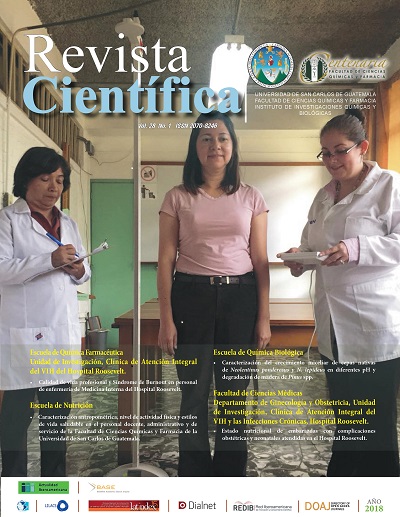Editorial
DOI:
https://doi.org/10.54495/Rev.Cientifica.v28i1.57Keywords:
editorialAbstract
In the framework of the commemorative celebration of the centenary of the Faculty of Chemical Sciences and Pharmacy, it is appropriate to make a historical reflection in which the timeline indicates in order that between the years 1401 to 1500 that made up the 15th century well called the century of innovations, people were prepared to obtain the title of "master apothecary", then according to the order of events in 1527 and 1528 history indicates that authorized doctors and apothecaries with technical - scientific knowledge of pharmacopoeia, chemistry and botany arrived in Guatemala; since by law apothecaries had to prepare medicines in compliance with the instructions of the Spanish pharmacopoeias, MacDonald Kanter and Chután Alvarado (2014)1. Going back in time, it can be mentioned that in the year 1840, Pharmacy studies were carried out at the Faculty of Medicine of the University of San Carlos de Guatemala. This is consistent with the fact that medicine is the genesis of the pharmaceutical sciences. In this context, it can be noted that formal pharmacy education in Guatemala began one hundred years ago. This historical context underscores the work that the Faculty of Chemical Sciences and Pharmacy of the Tercentennial University of San Carlos of Guatemala has done in the intellectual and professional training of generation after generation of Guatemalans in the pharmaceutical sciences, based on dialectical theory and principles. This has led to the development of other specialized programs that together have contributed to the country's medical and social development.
Downloads
Downloads
Published
How to Cite
Issue
Section
License
Copyright (c) 2018 Lissete Madariaga Monroy

This work is licensed under a Creative Commons Attribution 4.0 International License.
Authors who publish with this journal agree to the following terms:
- Authors retain copyright and grant the journal right of first publication with the work simultaneously licensed under a Creative Commons Attribution License 4.0 that allows others to share the work with an acknowledgement of the work's authorship and initial publication in this journal.
- Authors are able to enter into separate, additional contractual arrangements for the non-exclusive distribution of the journal's published version of the work (e.g., post it to an institutional repository or publish it in a book), with an acknowledgement of its initial publication in this journal.
- Authors are permitted and encouraged to post their work online (e.g., in institutional repositories or on their website) prior to and during the submission process, as it can lead to productive exchanges, as well as earlier and greater citation of published work.









